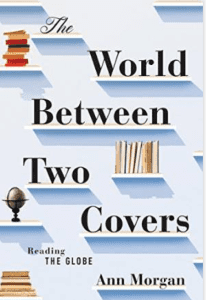
I am usually skeptical of any blog that finds its ways onto bookshelves by way of a quick Kafkaesque metamorphosis in the bowels of the publishing world. Ann Morgan’s extraordinary The World Between Two Covers, though, which began as a blog called A Year of Reading the World and was published last month by Liveright/Norton, avoids these pitfalls and triumphs as a standalone work of important literature.
The premise is simple. Morgan, a novelist, blogger, and journalist based in the United Kingdom, set out in 2012 to read a book from every country in the world, coinciding with England’s role as host of the 2012 Summer Olympic Games. What began as a highbrow Julie and Julia paradigm on her blog ayearofreadingtheworld.com quickly evolved into an overwhelming bibliographic task, as Morgan was confronted with political and cultural questions far more complicated than the enormity of fitting that many books into 365 days. It wasn’t just scheduling enigma, but rather an internal one, as she questioned her own identity as a reader and a writer.
Prior to the project, she made a tremendous realization. “My literary diet consisted largely of highly processed British and American staples,” Morgan writes. “I was comparable to one of those people who order chips in Chinese restaurants.…The awful truth dawned: I was a literary xenophobe.”
To remedy this literary xenophobia, she planned to “prescribe [herself] an intensive course of world literature,” but immediately stumbles upon the question not just of what books she’d chose, but rather, how would she even define a country? Ultimately, she relies on the United Nations’ List of Recognized States as her benchmark and sets off on a journey to actually find literature from each of the 196 countries included – published in English or requiring translation.
Morgan freely acknowledges and rebuts any criticism to her inherent bias as a privileged white woman growing up in a particular region of London as she selects the books. She frequently questions the definition of country and similarly the definition of literature. “For a certain breed of imperialist, it seems, reading the world can itself be a means of keeping it under control. And who’s to say that this book and the project behind it aren’t as continuation of that tradition every bit as much as they are in an attempt to continue the global conversation…?
Morgan approaches this issue in stride, however, questioning her own perspective as she broaches literature completely outside of her norm. She begins with some expected conclusions about literature (that books can “have a transformative effective … and enrich and broaden who we are”), but also takes on some unexpected and controversial topics.
For example, Morgan’s discussion on the ability for literature to actually change the physiology of our body is one that is quite new. She cites a well-known recent Brown University Study on how literary fiction helps increase the plasticity of the brain, to claim that “books don’t simply have the potential to transform our thinking; they can restructure our brains. . . adult brains retain a degree of plasticity throughout life, this means that, within certain limits, books have the power to shape us. Stories can make us who we are.”
This is the crux of her narrative and in turn a brilliant advertisement for the benefits of reading. Still, Morgan acknowledges its flaws. She writes:
“Just as texts appear to have power to formulate new pathways in our brains, so they can equally reinforce and shore up what is already there. Prejudices and ideologies can be bolstered by stories that flatter them and the boundaries of the world we live in can be hammered all the more firmly into place by books that simply replay familiar accounts of who and what we are.”
In full disclosure, Morgan and I were students on the same creative writing program at the University of East Anglia in England over ten years ago (though we never exchanged work) and because of that I knew of her blog and watched as it evolved over the year. This book is a new creation all its own, which may serve as a disappointment to some looking only for a list of interesting books to read. After all, the blog largely summarized the books that chronicled her search to find obscure translations from smaller countries. The book, however, does little to summarize her 196 selections, and reads more like a cultural excavation of the global literary landscape. It challenges the reader instead of merely suggesting reading material, and turns our own literary prejudices inside out. Why do we choose the books we read? What does that say about us? Should we even bother reading books in translation? The answer is an unequivocal yes.
Morgan is not an academic, and yet the reading of this book feels at once accessible and scholarly. By discussing literary criticism beyond her book selections, she turns a cerebral project into a fascinating analysis of what literature actually means. At its heart, The World Between Two Covers is a love letter to literature and a battle cry to read world literature. Impeccably researched, this book is less of a memoir and more of an intellectual Around the World in 365 Days. And in the process of writing this book, Morgan appears to have crossed the lines from intriguing blogger with a challenging premise, to serious cultural and literary critic.




